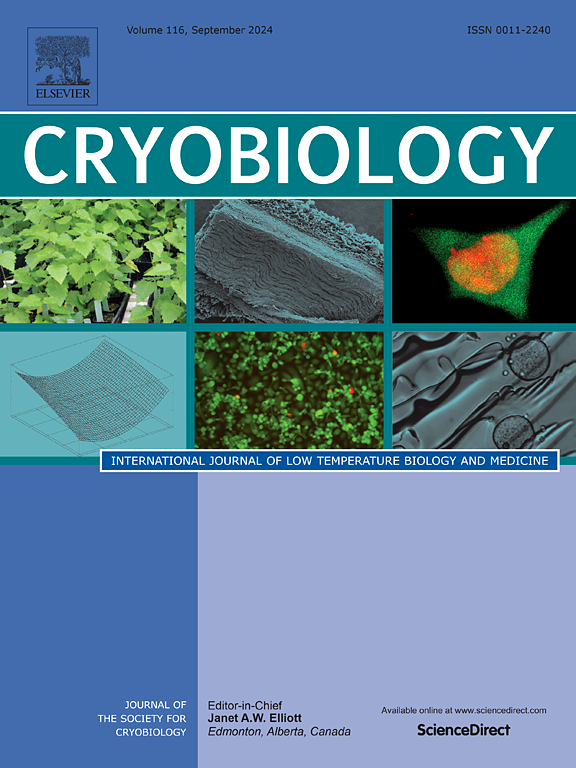微孔板-in-a- box:冷库高通量微孔板设计的热物理探索,以提高低温保存的速率控制
IF 2.1
3区 生物学
Q2 BIOLOGY
引用次数: 0
摘要
高通量实验筛选是理想的,以尽量减少从大量工作负载的数据采集时间。细胞冷冻保存实验通常在单样品低温瓶中进行,尽管细胞种子在96孔微孔板中进行,因为已知这些底物会诱导微升过冷,容易产生热压缩性,并且它们漫长的准备时间延长了细胞暴露于潜在的细胞毒性冷冻保护剂的时间。最近的努力集中在改进冷冻保护剂配方和补充预防性冰核剂上,而不是提高冷却方法的精确性。在这里,我们通过迭代设计建立了16个微孔板盒冷库装置,该装置可以在96孔微孔板中进行多样品慢速冷冻保存,同时确保生物最佳和可重复的冷却速度(1-3°C/min),以最大限度地减少细胞内和细胞外结冰的有害影响。最佳受体为31.9 × 25.8 × 20.5 cm, 4.3 cm厚的聚苯乙烯泡沫塑料受体,在- 80°C预平衡,内部有聚苯乙烯泡沫塑料绝缘,产生线性- 1.2°C/min的冷却速率,变化最小(±0.2),没有非线性热滞后。单个微孔板增加5.3倍,双微孔板增加10.7倍。影响最大的特征是微孔板插入前受热预平衡(IR = 7.0±0.5),微孔板的泡沫塑料绝缘(IR = 6.9±0.2),受热壁厚增加(IR = 5.8±0.5),微孔板在仪器内升高(IR = 3.5±0.1)和微孔板预平衡(IR = 2.7±0.2),所有这些都有助于热交换机制的衰减。使用普通实验室材料开发易于使用,易于构建的仪器,显著增强冷却速率控制,提高通量,可重复性和程序均匀性,对于最大限度地减少非生物因素对解冻后细胞活力的影响至关重要。本文章由计算机程序翻译,如有差异,请以英文原文为准。

Microplate-in-a-Box: thermophysical exploration of cold storage high-throughput microplate designs for enhanced rate control in cryopreservation
High-throughput experimental screening is desirable to minimize data acquisition time from vast workloads. Cell cryopreservation experiments are routinely performed in single-sample cryovials despite cell seeding being performed in 96-well microplates because these substrates are known to induce microliter supercooling, are prone to thermal compressibility and their lengthy preparation period extends cell exposure time to potentially cytotoxic cryoprotectants. Rather than improving the methodological preciseness of cooling, latest efforts have focused on refining cryoprotectant formulations and supplement precautionary ice nucleators. Here, we built 16 microplate-in-a-box cold storage apparatus by iterative design which allow multi-sample slow freezing cryopreservation in 96-well microplates while ensuring the biologically optimal and reproducible cooling rate (1–3 °C/min) required to minimize the deleterious effects of intracellular and extracellular ice formation. The optimal recipient, a 31.9 × 25.8 × 20.5 cm, 4.3 cm thick Styrofoam recipient pre-equilibrated at −80 °C with internal Styrofoam insulation, yielded a linear −1.2 °C/min cooling rate with minimal variability (±0.2), absent of non-linear thermal lag. Throughput increased by 5.3-fold for single and 10.7-fold for double microplate setups. The most impactful features were recipient thermal pre-equilibration before microplate insertion (IR = 7.0 ± 0.5), Styrofoam insulation of the microplate (IR = 6.9 ± 0.2), increased recipient wall thickness (IR = 5.8 ± 0.5), microplate elevation inside the apparatus (IR = 3.5 ± 0.1) and microplate pre-equilibration (IR = 2.7 ± 0.2), all of which contributed to an attenuation of heat exchange mechanisms. The development of easy-to-use, easy-to-build apparatus with common laboratory materials that significantly enables an enhancement of cooling rate control, improving throughput, reproducibility and procedural uniformity is essential to minimizing the impact of non-biological factors in post-thaw cell viability.
求助全文
通过发布文献求助,成功后即可免费获取论文全文。
去求助
来源期刊

Cryobiology
生物-生理学
CiteScore
5.40
自引率
7.40%
发文量
71
审稿时长
56 days
期刊介绍:
Cryobiology: International Journal of Low Temperature Biology and Medicine publishes research articles on all aspects of low temperature biology and medicine.
Research Areas include:
• Cryoprotective additives and their pharmacological actions
• Cryosurgery
• Freeze-drying
• Freezing
• Frost hardiness in plants
• Hibernation
• Hypothermia
• Medical applications of reduced temperature
• Perfusion of organs
• All pertinent methodologies
Cryobiology is the official journal of the Society for Cryobiology.
 求助内容:
求助内容: 应助结果提醒方式:
应助结果提醒方式:


